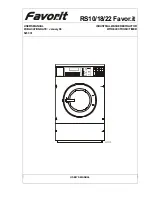
• When using detergent tabs, place them in the cutlery basket. The dis-
penser has been designed for powder or liquid detergent. As the cover
does not open completely during the washing cycle, tabs are not fully
released (dissolved). This could generate the following problems:
- insufficient detergent released during the cycle and poor washing
results;
- the detergent is compacted in the dispenser and is released during
the final rinse circle.
THE INTRODUCTION OF DETERGENT INTO THE RINSE AID
DISPENSER, EVEN IN LIQUID FORM, WILL DAMAGE THE
DISHWASHER.
5.3
General warnings and recommendations
Before using the dishwasher for the first time, it is advisable to read the
following recommendations concerning dish types to be washed and their
loading. There are generally no constraints on the washing of domestic
dishes, but in certain cases it is necessary to take their characteristics into
account. Before loading the dishes into the racks it is necessary to:
• remove coarse food remains: e.g. bones, fish bones, etc. which may
clog the filter or damage the wash pump;
• soak any pots or pans with burnt-on food remains on the bottom to
facilitate removal, then load them into the LOWER RACK.
Use the “
½ the load wash
” option (if available) for washing small amounts
of dishes; it saves water and electricity. When using this function,
only
load the rack selected for the ½ load wash
; the other rack must re-
main empty. There is no need to pre-wash the dishes under running water
before loading them into the racks since this only wastes water.
Correct
loading of the dishes helps ensure optimal washing results
.
WARNING!
• make sure that the dishes are securely in place so that they cannot tip over
or obstruct the rotation of the spray arms during the washing cycle;
• do not place very small objects in the racks as these could fall and obstruct
the spray arms or the wash pump;
• containers such as cups, bowls, glasses and pots should always be load-
ed with the opening facing downwards and with any cavities at an angle, to
allow the water to drain out;
• do not stack dishes or place them in such a way that they cover one other;
• do not place glasses too close together because they may knock against
each other and break, or there might be staining at the point where they
touch.
24
USER INSTRUCTIONS
EN
Содержание STU8642
Страница 2: ...2 EN...
Страница 36: ...Fig 6 02 A Fig 6 03 36 USER INSTRUCTIONS EN...
















































